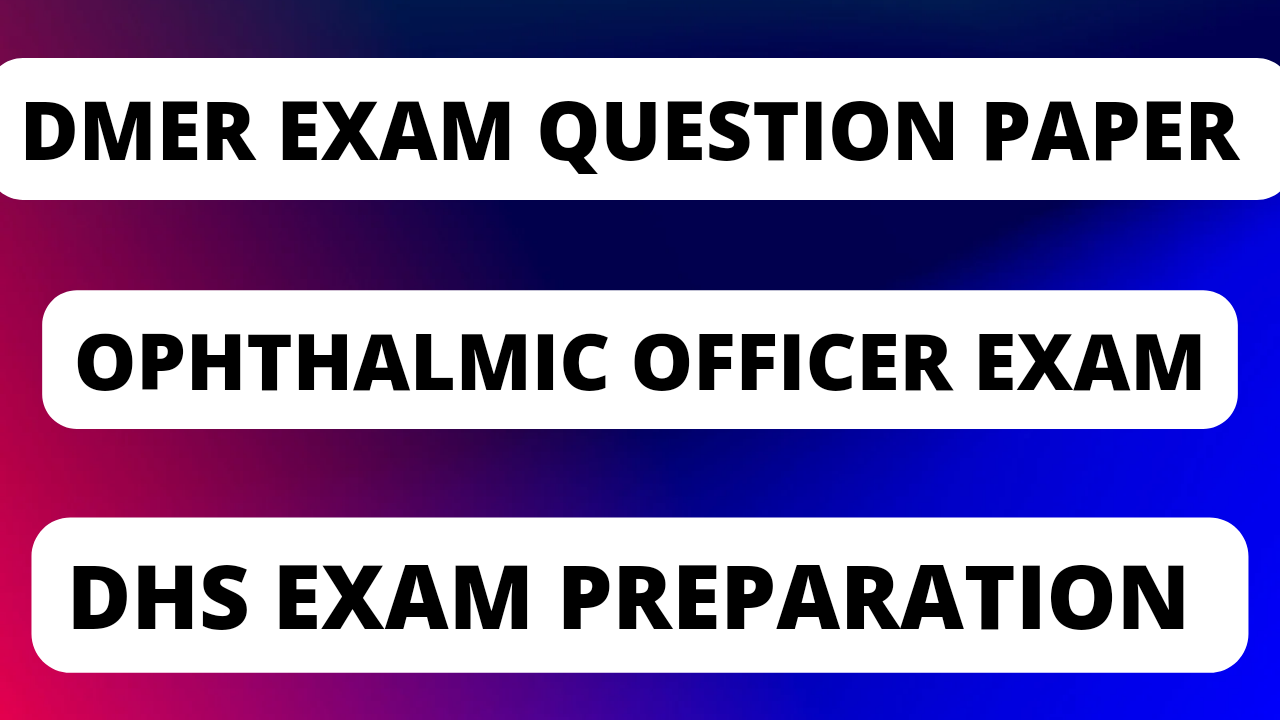DMER ONLINE EXAM 2023 OPTOMETRY QUESTION PAPER
Answer of MCQ question updating.......soon
Ophthalmic assistant DMER exam 2023 Question Paper
Q.1 Defending the body against microorganisms is the function of the:
1. lymphatic system
2. nervous system
3. respiratory system
4. excretory system
Q. 2 ................is the type of lens used in a camera.
1. Plano-concave lens
2. Convexo-concave lens
3. Biconcave lens
4. Biconvex lens
Q.3 Colour vision is tested using:
1. Perimetry test
2. Snellen's chart
3. Jaeger's chart
4. Ishihara's isochromatic chart
Q.4 ....................is the stage of nutrition associated with the intake of food.
1. Absorption
2. Digestion
3. Assimilation
4. Ingestion
Q. 5 Which colour will a green leaf appear when white light passing through a yellow filter falls on it?
1. Blue
2. Green
3. Red
4. Yellow
Q. 6 Stereoacuity is tested by all of the following EXCEPT:
1. Frisby test
2. Arden grating tool test
3. TND test
4. Titmus test
Q.7 Speed of light in vacuum is:
1. 200000 miles/s
2 250000 miles/s
3. 176000 miles/s
4. 186000 miles/s
Q.8 A crystalline lens absorbs light shorter than:
1. 590 n
2. 480 nm
3. 350 nm
4. 400 nm
Q.9 A cornea attains its adult size by:
1. 2 years
2. 4 years
3. 3 years
4. 3.5 years
Q.10 When we observe objects with only one eye, what is the difference in what we see?
1. We may find difficulty in distinguishing size.
2. There is no difference.
3. We may find difficulty in distinguishing depth.
4. We may find difficulty in distinguishing colour.
Q.11 Images formed by concave lens are:
1. inverted
2. enlarged
3. virtual
4 real
Q.12 ......................is the bacteria that can invade an intact cornea.
1. Staphylococcus aureus
2. Pseudomonas aeruginosa
3. Streptococcus pneumonia
4. Neisseria meningitidis
Q.13 For prism in air, the angle of deviation is determined by all of the following EXCEPT
1. refractive angle of prism
2. base of the prism
3. refractive index of material of which prism is made of
4. angle of incidence of ray
Q.14 In human eyes, maximum refraction takes place at the:
1. Anterior surface of the cornea
2. anterior surface of the lens
3. posterior surface of cornea
4. posterior surface of lens
Q 15. The sky is a blue because..
1. Air scatter blue light
2. Solar radiation is predominantly blue
3. Air emit blue light
4. Air absorb all light accept blue light
Q 16. Cataract is a condition where in
1. Lens fibre become more flexible than normal
2. Vitreous become opaque
3. Lens fibres become opaque
4. Aqueous become opaque
Q.17 All of the following organs are a part of the alimentary canal EXCEPT:
1. stomach
2. mouth
3. spleen
4. pharynx
Q. 18 Components of accommodation include all of the following EXCEPT:
1. increase in thickness of lens
2. pupil dilation
3. pupil constriction
4. convergence
Q. 19 Near vision is tested by keeping the chart at a distance of
1. 25-33 cm
2. 15-20 cm
3. 45-50 cm
4. 35-40 cm
Q.20 In a secondary rainbow, which colour is on the outside of the rainbow?
1. Red
2. Green
3. Violet
4. Blue
Q. 21 In which form is oxygen gas transported from the legs to the lungs?
1. Glucose
2. Oxyhaemoglobin
3. Carbonate ions
4. Carboxyhaemoglobin.
Q. 22 Which of the following is a part of neuron?
1. Node of Ranvier
2. Sarcoplasm
3. Lymph nodes
4. Sarcolemma
Q. 23 The twinkling of stars is due to atmospheric:
1. refraction of light
2. interference of light
3. reflection of light
4. dispersion of light
Q.24 ..............is used to correct astigmatism.
1. Cylindrical lens
2. Biconvex lens
3. Plane convex lens
4. Plane concave lens
Q. 25 Myopia is a condition wherein:
1. patient cannot see near object clearly
2. eyeball is smaller in size than normal
3. parallel rays coming from distant object are focused behind the retina
4. Patient cannot see distant object clearly
Q. 26 The refractive index of crown glass is:
1. 1.37
2. 1.33
3. 2.5
4. 1.52
Q.27 Cones in retina help us in:
1. seeing an upright image
2. magnifying an image
3. seeing in the dark
4. seeing different colours
Q. 28 ............is the blood vessel that carries deoxygenated blood from the heart.
1. Pulmonary vei
2. Aorta
3. Superior vena cava
4. Pulmonary artery
Q. 30 The curvature of the crystalline lens in an eye is changed
1. ciliary muscle
2. Horner's muscle
3. Muller's muscle
4. superior rectus muscle
Q.31 Near vision is affected by the instillation
1. proparacaine eye drops
2. timolol eye drops
3. pilocarpine eye drops
4. tropicamide eye drops
Q.32 In India. .............is the commonest cause of blindness.
1. glaucoma
2. cataract
3. trachoma
4. uveitis
Q. 33 Topical ocular anaesthesia is achieved by instilling. ............. drop in the eyes.
1 moxifloxacine
2. xylocaine
3. phenylephrine
4. tropicamide
Q. 34 The circular aperture present in the centre of the iris is called:
1. choroid
2. pupil
3. lens
4. cornea
Q. 35 The average pH of human saliva
1. 8
2. 7.8
3. 5
4. 6.8
Q. 36 Snellen's chart is used to test:
1. colour vision
2. visual acuity
3. visual field
4. contrast sensitivity
Q.37 discovered that sunlight consists of seven colours.
1. Isaac Newton
2. Galileo Galilei
3. Michael Farada
4. JJ Thomson
Q. 38 The anteroposterior diameter of a normal adult eyeball is:
1. 21.5 mm
2. 22.4 mm
3. 25.5 mm
4. 21 mm
Q. 39 Light emitted from a surface is measured in which of the following units?
1. Lux
2. Lumen
3. Candela
4. Lambert
Q. 40 The phenomenon of total internal reflection is involved in all of the following EXCEPT
1. Difference between apparent and real depth of a pond
2. Optic fibre
3. Rainbow formation
4. Sparkling of diamond

